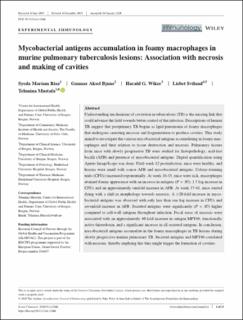| dc.contributor.author | Riaz, Syeda Mariam | |
| dc.contributor.author | Bjune, Gunnar Aksel | |
| dc.contributor.author | Wiker, Harald G | |
| dc.contributor.author | Sviland, Lisbeth | |
| dc.contributor.author | Mustafa, Tehmina | |
| dc.date.accessioned | 2021-03-12T12:10:31Z | |
| dc.date.available | 2021-03-12T12:10:31Z | |
| dc.date.created | 2020-05-30T17:16:15Z | |
| dc.date.issued | 2020 | |
| dc.identifier.issn | 0300-9475 | |
| dc.identifier.uri | https://hdl.handle.net/11250/2733160 | |
| dc.description.abstract | Understanding mechanisms of cavitation in tuberculosis (TB) is the missing link that could advance the field towards better control of the infection. Descriptions of human TB suggest that postprimary TB begins as lipid pneumonia of foamy macrophages that undergoes caseating necrosis and fragmentation to produce cavities. This study aimed to investigate the various mycobacterial antigens accumulating in foamy macrophages and their relation to tissue destruction and necrosis. Pulmonary tissues from mice with slowly progressive TB were studied for histopathology, acid‐fast bacilli (AFB) and presence of mycobacterial antigens. Digital quantification using Aperio ImageScope was done. Until week 12 postinfection, mice were healthy, and lesions were small with scarce AFB and mycobacterial antigens. Colony‐forming units (CFUs) increased exponentially. At week 16‐33, mice were sick, macrophages attained foamy appearance with an increase in antigens (P < .05), 1.5 log increase in CFUs and an approximately onefold increase in AFB. At week 37‐41, mice started dying with a shift in morphology towards necrosis. A >20‐fold increase in mycobacterial antigens was observed with only less than one log increase in CFUs and sevenfold increase in AFB. Secreted antigens were significantly (P < .05) higher compared to cell‐wall antigens throughout infection. Focal areas of necrosis were associated with an approximately 40‐fold increase in antigen MPT46, functionally active thioredoxin, and a significant increase in all secreted antigens. In conclusion, mycobacterial antigens accumulate in the foamy macrophages in TB lesions during slowly progressive murine pulmonary TB. Secreted antigens and MPT46 correlated with necrosis, thereby implying that they might trigger the formation of cavities. | en_US |
| dc.language.iso | eng | en_US |
| dc.publisher | Wiley | en_US |
| dc.rights | Navngivelse 4.0 Internasjonal | * |
| dc.rights.uri | http://creativecommons.org/licenses/by/4.0/deed.no | * |
| dc.title | Mycobacterial antigens accumulation in foamy macrophages in murine pulmonary tuberculosis lesions: Association with necrosis and making of cavities | en_US |
| dc.type | Journal article | en_US |
| dc.type | Peer reviewed | en_US |
| dc.description.version | publishedVersion | en_US |
| dc.rights.holder | Copyright 2020 The Authors. | en_US |
| dc.source.articlenumber | e12866 | en_US |
| cristin.ispublished | true | |
| cristin.fulltext | original | |
| cristin.qualitycode | 1 | |
| dc.identifier.doi | 10.1111/sji.12866 | |
| dc.identifier.cristin | 1813313 | |
| dc.source.journal | Scandinavian Journal of Immunology | en_US |
| dc.identifier.citation | Scandinavian Journal of Immunology. 2020, 91 (4), e12866. | en_US |
| dc.source.volume | 91 | en_US |
| dc.source.issue | 4 | en_US |

